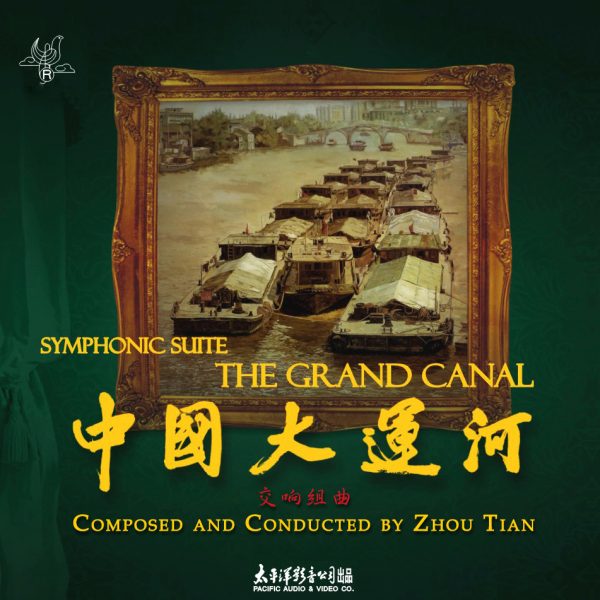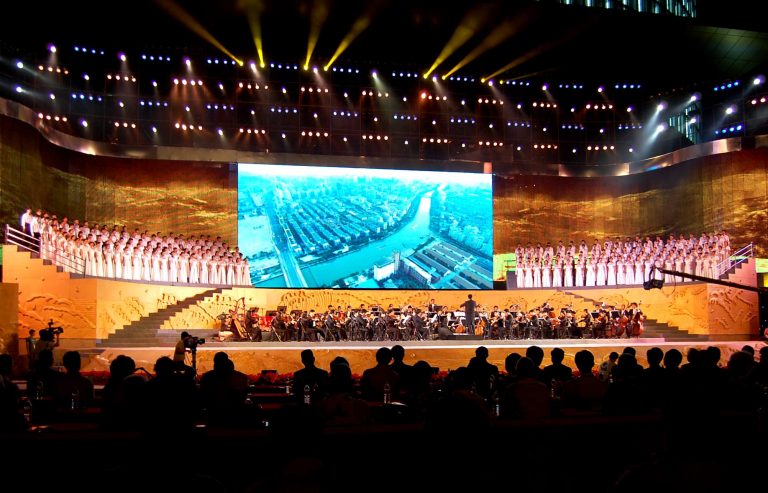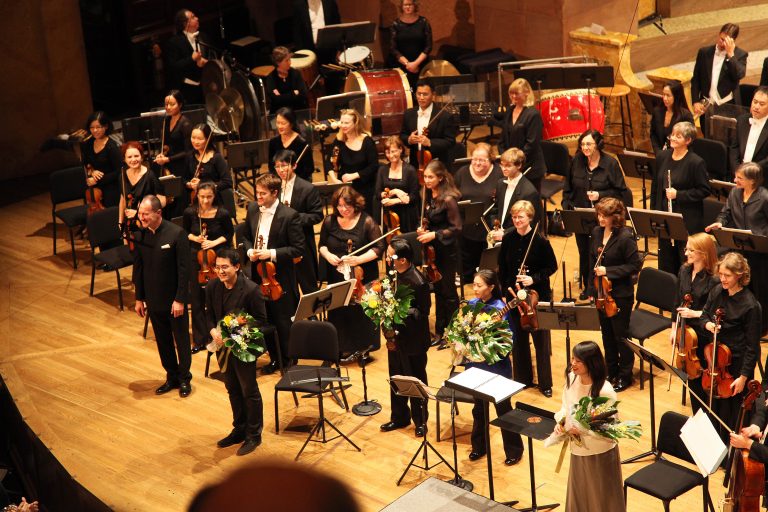
The Grand Canal
For erhu, ruan, Chinese opera singer, (mixed chorus), and orchestra
(2008) | 30/35 minutes
Commissioned by Hangzhou Federation of Literary and Art Circles
SCORING 1 (30 minutes)
3(picc). 3(corA). 3(Eb.Cl). 3(cbn) / 4431 / timp / 4 perc: large traditional Chinese Drum/Taiko Drum, Djembe (Mid, Large), Cymbals, Button Gong, Tamtam, Snare Drum, Bass Drum, Triangle, Vibraphone, Glockenspiel / hp / pno(cel.) / erhu (Chinese violin) / ruan (Chinese lute) / Chinese opera singer / str
SCORING 2 (35 minutes)
3(picc). 3(corA). 3(Eb.Cl). 3(cbn) / 4431 / timp / 4 perc: large traditional Chinese Drum/Taiko Drum, Djembe (Mid, Large), Cymbals, Button Gong, Tamtam, Snare Drum, Bass Drum, Triangle, Vibraphone, Glockenspiel / hp / pno(cel.) / erhu (Chinese violin) / ruan (Chinese lute) / Chinese opera singer / SATB chorus / str
PREMIERE
26 September – 1 October 2009, performed in nationally televised celebration of the 60th anniversary of the founding of the People’s Republic of China. Hangzhou Philharmonic Orchestra, Yang Yang, conductor
US PREMIERE
7 October 2012, Richardson Auditorium, Princeton, NJ. Princeton Symphony Orchestra, Rossen Milanov, conductor
RECORDING Guangzhou Symphony conducted by Zhou Tian, with Mao Weitao, Ma Lin, and Chen Feiya (Pacific PCD6421)
Snapshot
VI. Rhythm (ruan, choir, orchestra). Full version below
The Grand Canal celebrates one of the oldest and longest man-made waterways in the world, the Grand Canal of China, through a mosaic of sounds, old and new, and by mixing together two traditional Chinese instrumentalists (erhu and ruan), a Chinese opera singer/narrator, and a full symphony orchestra. Each of the 7 movements of the 35-minute work tells a distinctive musical story reflective of the canal’s history and culture. Commissioned by Hangzhou Federation of Literary and Art Circles, the work was performed during a nationally televised celebration of the 60th anniversary of the founding of the People’s Republic of China, chosen as a theme at 2010 Shanghai World Expo, and highlighted at MIDEM, the world’s leading international event for the music industry in Cannes, France.
Listen
I. OPENING (序): a celebratory fanfare. (Choir optional)
II. BEGINNING OF A DREAM (梦源): featuring a Chinese opera singer and narrator in the style of Yue Ju, accompanied by erhu and orchestra. (Choir optional)
III. SPIRIT (河魂): literary “River Soul,” a symphonic dance
IV(a). LIFE(生命): a hymn for the people who built the Grand Canal. (Choir required. Omitted in the orchestra-only version)
IV(b). MOTHER (母亲): the Grand Canal is known to the Chinese as the “mother river.” This slow movement contains melodies that were inspired by traditional Chinese music, featuring a Chinese opera singer and the erhu. (Choir optional)
V. RHYTHM (水韵):a rondo that beginnings with three soloists – the ruan, violin and cello—and develops into a full orchestra setting, all based on a distinctive Chinese rhythm. (Choir optional)
VI. THE GRAND CANAL (运河): a culmination of previous materials into a grand summary. (Choir optional)
Programme Note
Like the emblematic Great Wall, the Grand Canal of China is one of the oldest and most ambitious man-made structures in that country and the world. With a history spanning more than 1,400 years, the canal is the longest artificial waterway on the globe, running 1,794 kilometers from the northern capital of Beijing all the way south to Hangzhou. Along its course, it crosses five major rivers, the Haitong, Yellow, Huai, Yangtze, and Qiantang.
In commemoration of the 60th anniversary of the founding of the People’s Republic of China, Hangzhou Federation of Literary and Art Circles commissioned GRAMMY-nominated Chinese-American composer Zhou Tian to create a work that would celebrate the Grand Canal and its history while adding to an ongoing effort to gain recognition for the canal and its history as a World Heritage Site. The symphonic suite includes six movements, each incorporating diverse elements and demonstrating in different ways how the canal has been intertwined in the fabric of Chinese cultural life for more than a millennium. The 35-minute work celebrates one of China’s great landmarks, with grand scope and imagination.
The Grand Canal recording was selected as one of the 100 Important Audio and Video Publications of 2009 by General Administration of Press and Publication of China, chosen as a theme at 2010 Shanghai World Expo, and exhibited at MIDEM, the world’s leading international event for the music industry in Cannes, France.
One of Zhou Tian’s primary interests in composing the works was the opportunity to include traditional Chinese musical elements related to the culture of the Grand Canal in combination with the sonic resources of a Western symphony orchestra. In the composer’s own words: “because the Grand Canal is man-made by generations of workers, it is as much about people as it is about its beauty. In this symphonic work I used many traditional Chinese sounds, such as boatman’s chant, Erhu, Zhongruan, and Chinese opera singing and narration in the style of Yue, in an attempt to capture the essence of the humanity of the Grand Canal. Overall I wanted the piece to be a musical journey to many sides of the Grand Canal. It celebrates its history, culture reference, and beauty, and hopefully conveys a sense of grandeur, romanticism, and warm feelings along the way.”
Exploiting all of these resources in a kaleidoscopic fashion, the piece is comprised of six or seven movements (one movement, “Life,” which requires a full chorus is omitted from the orchestra-only version) to be performed as follow, with description from the composer.
I. OPENING (序): a celebratory fanfare.
II. BEGINNING OF A DREAM (梦源): featuring a Chinese opera singer and narrator in the style of Yue Ju, accompanied by erhu and orchestra.
III. SPIRIT (河魂): literary “River Soul,” a symphonic dance
IV(a). LIFE(生命): a hymn for the people who built the Grand Canal. (Choir required. Omitted in the orchestra-only version)
IV(b). MOTHER (母亲): the Grand Canal is known to the Chinese as the “mother river.” This slow movement contains melodies that were inspired by traditional Chinese music, featuring a Chinese opera singer and the erhu.
V. RHYTHM (水韵):a rondo that beginnings with three soloists – the ruan, violin and cello—and develops into a full orchestra setting, all based on a distinctive Chinese rhythm.
VI. THE GRAND CANAL (运河): a culmination of previous materials into a grand summary.


